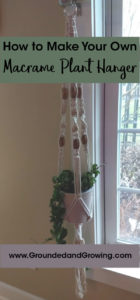 Creating DIY macramé plant hangers are a little bit like eating potato chips– you probably won’t be able to stop at just one! With a few simple directions and materials you’ll be on your way!
Creating DIY macramé plant hangers are a little bit like eating potato chips– you probably won’t be able to stop at just one! With a few simple directions and materials you’ll be on your way!
This post contains affiliate links for your convenience. I only promote products I love.
As a kid of the late ’70’s and 80’s we had a chrome plant pole in the living room with hooks sticking out at various angles. Maybe you had one at your house– it was a tension rod that rested with one end on the ceiling, the other end on the floor. I remember my mom hanging a pothos plant there in a macramé plant hanger with stems that snaked up, down and around.
Over time, I became way more interested in hanging plants there than my mom. You pretty much couldn’t see the pole for all the hanging plants during my high school and college years.
My mom was pretty much over and done with the plant pole by the time I went to grad school in the late ’90’s. Honestly so was the rest of the world, but I didn’t care. It gave me more space for plants.
I took the plant pole with me to grad school– by then its chrome was dotted with tiny bits of rust and some of the hooks were a bit wobbly. But it served me well in my apartment and even came with me to my job in Extension. The only reason I stopped using it was it didn’t reach the ceiling when we moved to a new Extension office. By then the rust had multiplied and strategic use of duct tape kept some of the hooks in place. It was probably time to retire it to the dumpster anyway.
Love ’em or Hate ’em, Macramé Plant Hangers are Back
The only hanging plants I’ve had for years have been outside on shepherd hooks in the summer. But I started seeing the old school macramé plant hangers in stores the last few years. It’s really not surprising that they’re coming back given the resurging popularity of houseplants and gardening in small spaces. Hanging houseplants allows for use of vertical space, opening up so many possibilities if space is limited.
Truth be told, I bought some supplies to make a plant hanger back when I had first started this blog in 2016. But I was just winging it– I had no real plan on how to do it, and with a newborn in the house at the time, these craft supplies never left the bag from when I bought them!
Flash forward to this fall, and I read mention of a new macramé book, Modern Macramé, that had a whole chapter on plant hangers, the “gateway drug” to macramé as the author called them. I read that description and thought “I’ve found my people.” So of course I bought a copy.
The book did not disappoint. I wanted to make every plant hanger in the book. And maybe a pillow or two. And the daybed looked interesting..… Well, you get the point. There’s no shortage of ideas in the book.
I sat down to order supplies and the Modern Macramé book has a companion website selling supplies for the book’s projects. As much as I loved the selection there, the prices were pretty steep. So I set out to find comparable supplies on Amazon for my projects. The links for everything mentioned in this post are listed below for your shopping convenience.
Supplies List:
** Supplies in green are affiliate links for your shopping convenience.
- Modern Macramé book
- 1.25″Metal rings— Each plant hanger uses one; this link is for a 10-pack
- 5mm Cotton rope— I used natural white but there are tons of colors out there; each ball of this particular natural white rope is 198 feet long. The Single Plant Hanger and Beaded Cotton Rope Plant Hanger each use 99 feet; the Recycled Fabric Rope Plant Hanger uses 31.5 feet.
- 4 mm Jute rope— The Beaded Plant Hanger (Jute) uses 120 feet.
- Wooden beads— Note these come in different colors too! You will need 6 beads for either beaded plant hanger in this post.
- Recycled 1/4″ fabric rope— This is super variable in overall length and colors; even so it was fun to work with!
Two Knots, Many Options
Making the plant hangers mentioned in this post rely on knowing how to do two basic macramé knots: the half-square knot (HSK) and right half-square knot (RHSK). Done together (HSK then RHSK), these two knots create a square knot (SK).
Half-Square Knot (HSK)
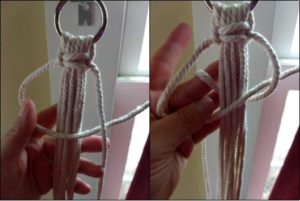
Left: Two outside cords are the working cords, the rest are “filler” in the center. Bring left working cord across and in front of filler cords and under right working cord. Right: Bring right working cord behind filler cords and up over the left working cord. Tighten knot, being careful to smooth filler cords.
Right Half-Square Knot (RHSK)
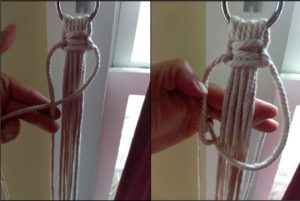
Left: Two outside cords are the working cords, the rest are “filler” in the center. Bring right working cord across and in front of filler cords and under left working cord. Right: Bring left working cord behind filler cords and up over the right working cord. Tighten knot, being careful to smooth filler cords.
Finished Knot Examples & Counting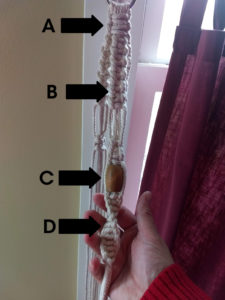
A. Two square knots anchor the cords to the metal ring.
B. Square knots worked one after the other are called a sinnet. Here there are six square knots in the sinnet. Count the knots by counting the number of vertical bumps along the left side.
C. Example of a wooden bead incorporated into the plant hanger. The working cords extend along the outside of the bead, and the filler cords are threaded through the hole in the bead.
D. Multiple half-square knots worked in a sinnet will produce a spiral that twists to the right. Multiple right half-square knots would create a spiral twisting to the left.
Single Plant Hanger (Cotton)
The first plant hanger I tried making was the “Single Plant Hanger” on page 47 in Modern Macrame. All it calls for is 5mm cotton rope and a 1.25″ metal ring. Should be simple, right? Well….it’s simple if you focus on what you’re doing. I was trying to talk to a friend and cut the lengths of rope for this project, and ended up with six 10.5′ pieces instead of six 16.5′ pieces. This messed up my master plan to get two of these hangers from the ball of cotton rope I bought– but by the time I cut new pieces and finished my first hanger, I had an idea for the 10.5′ pieces. See below under “My Own Designs”.
Beaded Plant Hanger (Jute)
Jute was another material that caught my eye in the Beaded Plant Hanger on page 55 of the Modern Macramé book. I’d consider jute to be one of the more sterotypical macramé materials. Lots of people think hippies and beads when you mention making anything from jute. For those plant geeks out there, jute is made from stem fibers of a tropical plant in the mallow family. It’s one of the most affordable natural fibers on the planet and second only to cotton in the amount produced and the variety of uses. It’s also the same fiber used to make burlap.
My Own Plant Hanger Designs
Recycled Fabric Rope Plant Hanger

My first inspiration was fueled by frustration. I took three of the 10.5′ 5mm cotton rope mistakes from my first attempt at a “Single Plant Hanger” and cut three additional 10.5′ lengths from recycled rope made from discards from an Indian fabric manufacturer. The description says it’s made of jute but it feels like cotton to me.
Instructions:
- Cut 3, 10.5′ lengths from plain 5mm cotton rope, and 3, 10.5′ lengths from recycled fabric rope
- Thread lengths through a 1.25″ metal ring so the ring is at the halfway point. Secure cords to the ring with 2 SKs as in the Basic Plant Hanger from Modern Macramé, using two of the multi-colored recycled fabric ropes as the working cords. Also see ‘A’ under ‘Finished Knot Examples’ above.
- Divide the 12 cords into three sets of four cords each. Each set should have two multi-colored and two plain cords.
- For each set of four cords, use two multi-colored ropes as the working cords. Add knots as follows:
- 3 SK
- 2″ below add 2 SK
- 6″ below add 1 SK
- 3″ below add 1 alternating square knot (ASK) (two cords from one set and two cords from an adjacent set make one SK. See picture and description below)
- 3″ below add 1 ASK
- Immediately below add 1 ASK
- Using two of the longest multi-colored ropes as working cords, add 12 HSKs to create a spiral.
- Trim cords at least 6″ below the lowest knot.
Alternating Square Knots (ASK)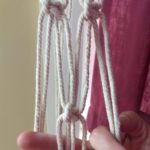
Be forewarned, reading how to do this made no sense. It wasn’t until I had the cords in front of me that it all miraculously made sense.
Repeating rows of alternating square knots make the “basket” that holds the plant pot in a macramé plant hanger. Setting up the basket starts with a set of square knots on the each set of cords.
To create an alternating square knot, take half the cords from one set and combine with half the cords from an adjacent set. Create another square knot using these cords. The finished knot should be midway between the knots in the previous row. See picture.
By varying the placement of alternating square knots in relation to the previous row, you can customize any plant hanger pattern to fit whatever pot your plant is in. Generally speaking, the first row is usually in line with the top of the pot, and the third-to-last row lines up with the bottom of the pot, and the last two rows are placed back-to-back a short distance from the “bottom of the pot” row to provide more support to the pot.
Beaded Cotton Rope Plant Hanger
After making the “Single Plant Hanger” and “Beaded Plant Hanger” from the Modern Macramé book, I loved how the beads looked on the jute hanger. In my supply-purchasing excitement, I had purchased two different colors of wood beads. I didn’t like how the lighter color looked with the jute, which got me thinking about pairing them with the cotton rope….. and my other design emerged.
Instructions:
- Cut six, 16.5′ lengths of 5mm cotton rope
- Thread lengths through a 1.25″ metal ring so the ring is at the halfway point. Secure cords to the ring with 2 SKs as in the Basic Plant Hanger from Modern Macramé. Also see ‘A’ under ‘Finished Knot Examples’ above.
- Divide the 12 cords into three sets of four cords each.
- For each set of four cords, use two outer ropes as the working cords, and the two center cords as filler. Add knots as follows:
- 6 SK
- 2″ below add 2 SK
- Thread both filler cords through the center of one wooden bead
- Add 2 SK immediately following the bead
- Add 11 HSK to creating a spiral
- 2 SK
- Thread both filler cords through the center of one wooden bead
- Add 2 SK immediately following the bead
- 7″ below add 1 SK
- 3″ below (or distance to bottom of pot) add 1 alternating square knot (ASK) (two cords from one set and two cords from an adjacent set make one SK. See picture and description above)
- 2″ below add 1 ASK
- Immediately below add 1 ASK
- Using two of the longest ropes as working cords, add 12 HSKs to create a spiral.
- Trim cords at least 6″ below the lowest knot, unravel the rope to create tassel
How-to on Hanging
Now I just have to figure out where to hang my plants. Depending on the size and type of pot, some hanging plants can be really heavy. Do keep this in mind before you attach hooks to your walls or ceiling. Usually they have to be anchored properly to bear any weight.
I’ve considered buying a new tensioned plant pole, similar to the one my mom had years ago. There are also some hooks to attach to walls or the ceiling, freestanding options, and even a suction cup window hook for smaller macramé projects.
I hope you’ll try your own hand at making a plant hanger– or two or three. There is something innately relaxing about the process, and having something functional and beautiful for your home at the end of it all is a feeling you can’t buy anywhere.
For more information about houseplant care and display options, check out my posts on winter houseplant care and houseplant pest control.
If you liked this post, please subscribe to Grounded and Growing today and receive your copy of “15 Tips to Become a '15 Minute Gardener'” so you can spend less time working ON your garden and more time enjoying being IN your garden.! It’s absolutely free. When you join the Grounded and Growing community, you’ll finally take the garden off your “To-Do” list and allow yourself time to enjoy your garden and savor the peace and serenity there. I tell subscribers about new posts as soon as I hit ‘publish’ and send weekly-ish updates on what’s going on in my garden– good, bad AND ugly.

All Rights Reserved. © 2019 Jennifer Schultz Nelson.
[…] When you get your pest problems under control, why not try your hand at propagating African violets, or making a macramé plant hanger? […]